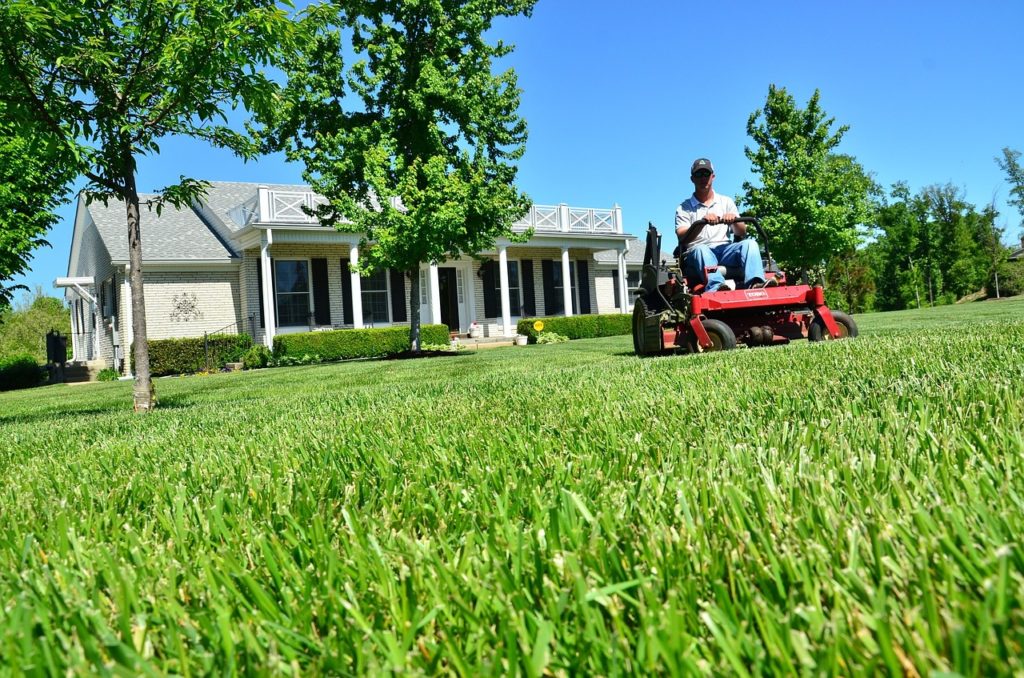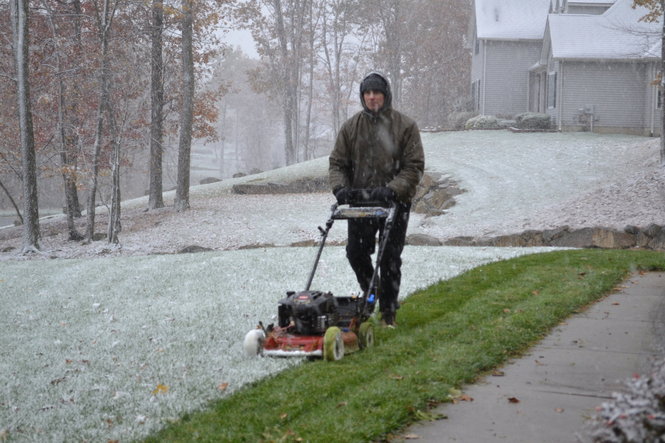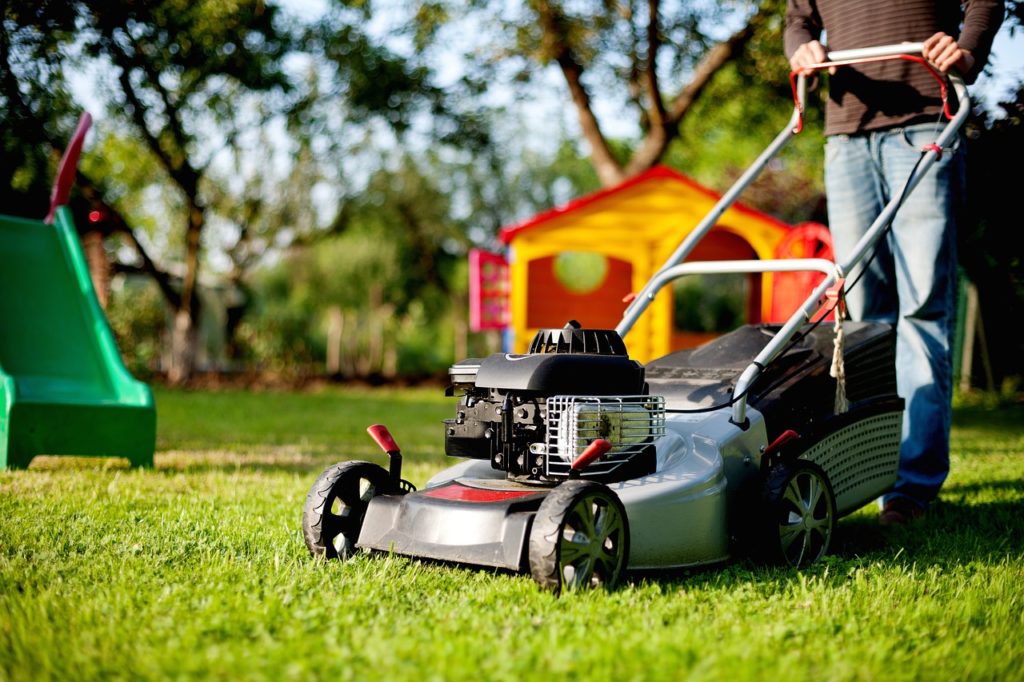The advent of summer has prompted many homeowners to start mowing their lawns. Mowing a lawn offers a lot of benefits. It keeps your lawn neat, tidy, beautiful, and healthy. However, not many people have slightest of an idea about how often to mow lawn. Some people cut the grass too often while others don’t mow theirs as frequently as needed. Similarly, they have no clue whatsoever of the best time to cut that overgrown grass.
In this article, we are going to explain everything about keeping your lawn in the best condition possible including how to mow the lawn and what should be the grass cutting frequency.
We have also divided the article into the following sections for your convenience.
- Benefits of mowing lawn regularly
- The ideal lawn mowing frequency
- How often should you mow your lawn in winter?
- How often to mow the lawn in spring?
- The lawn mowing frequency in summer?
- How often to mow lawn in fall/autumn?
- Disadvantages of over mowing and under mowing the lawn
- Understanding different types of grasses
- General Factors to Consider when mowing the lawn
So, let us begin our journey towards a well maintained, tidy, and an enchanting lawn for all seasons.
Benefits of Mowing Your Lawn Regularly
Before we actually discuss the lawn mowing frequency and the best time to mow the yard, it is appropriate to highlight some of the benefits of mowing your lawn regularly. You also need to keep in mind that different species of grass depends upon their cutting height to grow and thrive. The following are the main advantages of mowing lawn after certain intervals.

1. Grass Gets Stronger
Mow your lawn as often as required to get strong lawn grass. Cutting the grass at the right height leaves weak grass shoots behind, only allowing the strong shoots to flourish. Therefore, your grassroots will be healthier if you cut the grass more often. As a result, you get a lush green, stronger, and healthier lawn over time.
2. Even Grass Growth
Regular mowing can help you overcome one of the most common lawn problems that is uneven growth of grass. The overall grass growth will improve considerably provided you mow the lawn to a uniform level after regular intervals because it ensures equal distribution and absorption of nutrients obtained from sun and water. Growth consistency is essential for maintaining a beautiful lawn.
3. Increased Nourishing Mulch
Proper mulching is synonymous with a beautiful and healthy lawn. It is vital for returning the essential nutrients to the soil after mowing. Regular lawn mowing results in a constant supply of mulch consisting of shorter grass blades which are much healthier than longer blades. Longer blades are comparatively much weaker as they have fewer nutrients.
4. Faster Lawn Recovery
Your lawn is a perpetual target of nuisances such as diseases, inclement weather, and all sorts of pests. Remember that a well maintained and healthy lawn will recover faster than unhealthy lawns. The only way to keep the lawn immune to diseases and pests is to mow it regularly.
Similarly, it becomes increasingly difficult for a lawn with long grass to get back in shape if you leave it unmowd for a long time.
5. Eliminates Pests
It is easier for pests to infest an overgrown lawn compared to a well mowed one. Both bugs and rodents find easy refuge in weed and tallgrass, spreading deadly diseases in addition to ruining the beauty of your lawn.
You can easily deter the pests by cutting the grass regularly. However, it is better to take remedial measures if pests and rodents have already taken over your lawn.
The Ideal Lawn Mowing Frequency
How often do I need to mow my lawn? This is the most common question homeowners with their own lawns ask. Well, it all depends upon the time of the year you are mowing the lawn. Similarly, many other factors will determine the ideal mowing frequency for your lawn. Some of these factors are as below.
- Required or desired grass height
- The region you live in and average temperature
- Cold, frost, and snow conditions
- The availability of water, sunlight, nutrients, and or absence of the same will play a huge part in determining your lawn mowing frequency.
- Availability of nutrients
- Type of ground
In the following lines, we are going to breakdown how often to mow lawn in each season. We will also analyze various factors that determine how often to cut grass during every season.
How often should You Mow Your Lawn in Winter?
Most people ignore their lawns in winter altogether. In fact, some of them love winters thinking there is no need to cut the grass in colder months. However, they are far from the truth. Your lawn indeed stops growing when temperatures fall below 40 degrees Fahrenheit. The grass will not grow as quickly as in spring or summer even in the areas that don’t receive snowfall.

In short, you may not have to mow your lawn at all in winter, especially if the temperature falls below the standard 40 degrees F.
However, grass can grow to some extent during winter in exceptional cases such as:
- The temperature is above 40 degrees Fahrenheit for several days in a row.
- Some parts of the country or region receive prolonged sunlight.
- You may also have to mow the grass if it remains dry.
Above mentioned are some of the cases when you may consider mowing your lawn in winter as well. However, try to consider the following things when you think it is time to mow the lawn in colder months.
1. Never Cut Wet Grass
The first rule of thumb is that you should never cut wet grass. It is necessary to avoid mowing the lawn immediately after the rain, snowfall or formation of dew. Similarly, avoid mowing the lawn if you live in an area with rainy winters. Tallgrass and muddy soil only damage your lawn’s roots. Therefore, you should wait until the grass dries down.
2. Wait till the End of Season
Another mistake people commit is to mow the lawn on a solitary hot day of winter. It is one of the worst lawn mowing practices, to say the least. Wait for the long heat waves where temperature constantly remains above 40 degrees Fahrenheit for days. In my opinion, you should postpone the lawn mowing till the end of the season. Similarly, leave your lawn alone once you are done mowing. It will help your lawn better prepare to combat whatever cold is yet to come.
3. Keep Blades Higher than Normal
As the grass does not grow in winter, you need to keep it higher before mowing it.
As mentioned above you don’t have to mow the lawn as often in winter as in spring or summer. There are some parts of the country or even rest of the world where you don’t bother cutting the grass in winter at all. However, proceed with caution if you have to mow the lawn from November to February.
How Often to Mow Lawn in Spring?
Spring can actually be the best time to mow the grass and get it ready for the barbecue season. This is the time of the years when snows begin to melt, the sun starts shining higher, and birds resume chirping. It is also the very first time of the year to dust off your lawn mower and cut the tall overgrown grass. However, you still need to be extra careful.
How often to mow lawn in spring still depends upon the rain levels and temperatures. Similarly, you should not get too eager as well. Try to resist the temptation of bringing your lawn mower out at the first sign of spring. You need to spend some time to access your lawn. This is necessary because a healthy and neat lawn in spring means a healthy and neat lawn for the rest of the years.
The following are some of the factors you should consider before making a lawn mowing schedule for spring.
4. How Tall is the Grass?
Never try to cut grass before it is at least two inches long, even in spring. The golden rule of thumb is that you should only cut one-third of the grass (the one-third rule). Therefore, set your mower’s height accordingly after checking the initial length of the grass.
5. When Did You Last Fertilize?
When did you last fertilize your lawn? It is essential for the lawn to fully absorb the fertilizer before you can mow it.
6. Do You Plan to Overseed Your Lawn?
The best time to mow is late spring if you plan to overseed the lawn this spring. Mowing too early will be disastrous for your lawn. It can smoother the seedlings if you are using too much mulching power. On the other hand, it can also rip them out of the ground.
7. Always Consider the Weather
Try to wait as long as possible if your lawn is still thawing from snow or harsh winters. Keeping the lawn longer increases its chances of staying healthy.
8. Mow every Three to Five Days
It is imperative for you to mow the lawn every three to five days after the initial mow. It will help you keep your healthy, clean, and beautiful.
The Lawn Mowing Frequency in Summer?
Summer is the best time of the year for everyone including your lawn. Lawns and gardens thrive in summer because of warmer weather. Everything else also looks up and starts flowering, further adding to the beauty of your lawn.

However, the grass will grow incredibly fast in summer, compared to winter. In fact, it can grow much faster and longer than it did in spring. It also means you have to increase the lawn mowing frequency in summer. So, how often to mow lawn in summer?
It is pertinent to mention that every lawn is created differently. Just because your neighbors’ lawn looks fantastic because they mow it every two weeks does not mean the same frequency is ideal for your lawn too. In fact, your lawn care routine determines how much your lawn grows and how often to cut grass.
As a matter of fact, you have to take all the points into account while mowing the lawn in summer which you did during springs. Following is a brief summary of all those points.
- To begin with, how tall is your grass?
- Have you fertilized your lawn this summer or planning to do so?
- Will you overseed your lawn?
- What is the weather forecast? Will it be hotter or colder?
- Are you relying on the rain to supply water for the lawn or do you have an irrigation system in place?
Here are a few more things to bear in mind.
1. Follow the One-Third Rule
You have to follow the one-third rule of cutting the grass in summers, just like spring. Once again, it is the length of the grass that determines the mowing frequency.
2. Keep Your Grass Longer
Most experts recommend keeping your grass longer in summer than you had in spring. As compared to the springtime length of 2 inches, the recommended grass length for summer is roughly 3 inches. Longer grass tends to be more beneficial for your lawn, especially during droughts which are becoming more and more common during summer months. The longer the grass, the more your lawn will be sustainable.
3. Cut Your Lawn Every Four Days
Experts also recommend cutting your lawn every 4 days during summer. This is because the grass takes 3 to 5 days on average to grow about 1 inch. Mowing lawn every four days will help you keep the grass height at the optimal length.
Besides, you can keep your lawn hydrated and healthy during the hottest part of the year.
How often to mow the lawn in fall/autumn?
The yard mowing frequency decreases in fall because the grass grows much slower than summers. However, fall is the best time of the year to prepare the lawn for winter. As with all other seasons, the mowing frequency greatly depends upon the type of grass and temperature.
Ideally, you should mow the lawn every 1.5 to 2 weeks during the fall. However, you may have to mow the lawn once in a week if you are living in states like Florida or warmer countries.
It is worth mentioning that there is no hard and fast rule when it comes to lawn mowing frequency. You may have to mow lawn once in a month or twice a week. It all depends upon different factors such as temperature, type of grass, irrigation system, or fertilizing needs.
Disadvantages of Over Mowing and Under Mowing the Lawn
You must have a fair knowledge and understanding of how often to mow lawn in different seasons by now. However, you can still end up over mowing or under mowing your lawn with drastic consequences. In fact, this is one of the most common yet biggest mistakes lawn owners make while trying to maintain a healthy and beautiful lawn.
Disadvantages of Over Mowing the Lawn
Mowing your lawn too often entails many disadvantages and dangers. Some of these dangers are explained below.
1. Damaging the Roots
Mowing the lawn too frequently will inflict considerable damage to the grass roots. Besides, it will also hinder the growth of weeds. Although weeds are bad for your lawn yet you cannot fully eliminate them as they fill the void.
2. Depleting the Nutrients
You will do a big disfavor to your lawn if you mow it as soon as it starts to spring. It will deprive your lawn of all the required nutrients no matter how you much you fertilize it.
3. Damaging the Grass
You can even damage the grass and prevent it from blossoming if your lawn mowing frequency is too high. However, it also depends upon the type of grass your lawn has.
4. Uneven Growth
Your lawn can grow unevenly in case you tend to over mow it. As a result, it will remain uneven and become unpleasant for eyes.
5. Faster Growth
In addition to uneven growth, your lawn may grow faster than normal. This is especially troublesome if everyone in your house hates mowing the lawn. Therefore, it is important to understand the type of grass and growth patterns.
Disadvantages of Under Mowing the Lawn
Over mowing the lawn is dangerous but it is equally disadvantageous to under mow the lawn as well. Some of the problems you may face are as under.
- Your lawn will look untidy as there will be a lot of tall or overgrown grass.
- Pests and rodents will start infesting your lawn.
- Under mowing also results in damaging the grass and uneven growth, especially in areas where frequent mowing is necessary.
- It will take more time and effort to finally mow the lawn.
- Not only your lawn but your entire home will look shabby in case of a ramshackle lawn. A beautiful and tidy lawn is an essential part of your home’s aesthetic appearance.
Understanding Different Types of Grass
The two driving factors which determine how often to mow lawn are the season of the year and the temperature. However, there is another important consideration that is the type of grass planted in your lawn. In fact, it is as important a factor as the other two when it comes to determining the lawn mowing frequency.

The following are a few cold-season and warm-season grasses and their ideal cutting length.
Cold Season Grasses
- Fine Fescue: 1.5 to 2.5 inches
- Tall Fescues: 2 to 3 inches
- Kentucky Blue Grass: 1.75 to 2.5 inches
- Bent Grass: 0.25 to 1 inch
Warm Season Grasses
- Bahia Grass: 2.5 to 4 inches
- Centipede Grass: 1 to 2.5 inches
- St. Augustine Grass: 1 to 3 inches
- Hybrid Bermuda Grass: 0.5 to 1.5 inches
General Factors to Consider when Mowing the Lawn
At the end of our article, we will also discuss general factors to consider when you have to determine how often to mow lawn in different seasons. We also highlight some important lawn mowing tips for you as well.
1. The Grass Growth Rate
How often to cut grass normally depends upon how fast the grass in your garden grows. Some grasses grow faster than others. Therefore, they require more mowing as well. Most people mow their lawn once a week on average during spring and summer, the two main grass growing seasons. It is enough to keep your lawn beautiful and healthy.
You can reduce the mowing frequency in the fall and winter. It is better to mow the lawn only when required. It is enough to mow your lawn once in a month or after every two weeks. However, it primarily depends on the grass type in your garden.
2. The Type of Grass
We cannot stress this factor enough. Different types of grasses grow in different seasons. In simple words, you should mow cold season grasses in early fall or spring and warm-season grasses in summer.
3. The Grass Height
You may tend to follow the general grass mowing schedule which is a good thing to do. However, you need not always follow the schedule. Every lawn has its own characteristics and individuals requirements which you must pay special attention to.
For example, your grass should be tall enough every time you decide to trim it. Always remember that cutting grass too short will damage the grass roots. Similarly, the grass will be unable to absorb the water and nutrients appropriately. As a result, it will adversely affect the appearance and health of your lawn.
4. The “One-Third of the Length” Rule
It is also a big mistake to cut the overgrown lawn too short in an attempt to heal it. It will only stress the grass, preventing it from absorbing the required nutrients and food. It will result in drastic consequences such as brown grass which you are not going to like at all.
The best way to mow the lawn is to cut the grass blades only to one-third of their height at a time. There is nothing wrong with having shorter grass but you have to attain your goal gradually. Mow your lawn frequently but not more than one-third of the blades’ length at a time. Repeat the procedure and you will eventually get the desired grass height albeit slowly and steadily.
5. Always Mow the Lawn when it is Dry
Can you mow a wet lawn? The straight answer is no. The best lawn mowing practice is that you should always cut your grass when it is dry. Similarly, try to mow the lawn only after the night dew has dried up. The grass will only get stretched and heavy after watering or raining, making it difficult for you to mow it.
6. How to Water and Fertilize the Lawn?
How fast your grass grows is directly dependent on how much you water the lawn and the type of fertilizer you use. In short, the grass will grow more quickly if you add water and fertilizer to the soil too frequently. Consequently, you will have to mow the lawn more frequently as well.
Final Thoughts
There is no hard and fast rule when it comes to how often to mow the lawn. It all depends on your area, weather conditions, temperature, and the type of grass. We hope this guide will help you create a well maintained, healthy, and lovely yard outside your home irrespective of your area or weather.






Thanks for the tip that St. Augustine grass would be in need of mowing once it reaches three inches in height. I’m thinking about getting a regular lawn mowing service for my vacation house so that its front lawn wouldn’t look abandoned if not in use for a long time. I will have to keep track of the growth of my grass for the whole of next year in order to know how many times in a year would I need lawn mowing services.